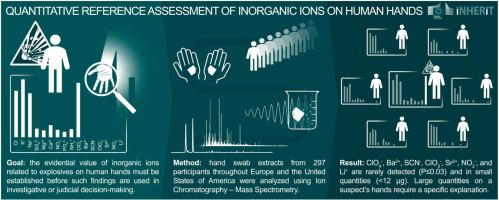A study into the natural occurrence of inorganic ions relevant to forensic explosives investigations on human hands
Abstract
The natural occurrence of 16 inorganic ions relevant to forensic explosives investigations on human hands was studied to support the evaluation of activity-level propositions when such traces are found on the hands or in the fingerprints of a suspect. A total of 594 hand swab extracts from 297 participants throughout Europe and the United States of America were analyzed using Ion Chromatography – Mass Spectrometry. The data provides a reference framework for future covert investigations and forensic casework. The results indicate that thiocyanate, chlorate, nitrite, lithium, strontium, and barium are rarely detected on the hands of individuals who have had no direct contact with explosives (P<0.03) and in quantities below 6 µg. Perchlorate contamination sporadically occurs without deliberately handling perchlorates (P=0.03), albeit at low levels (<12 µg). It also seems that the presence of perchlorate on hands is generally related to professions that involve explosives. Detecting substantial amounts of any of these rare ions on a suspect’s hands would require a specific explanation. Because legitimate activities exist that can also result in elevated levels of ions of interest on hands, the context surrounding their presence has to be carefully assessed for each individual case.


| 公司名称 | 产品信息 | 采购帮参考价格 |
|---|
 求助内容:
求助内容: 应助结果提醒方式:
应助结果提醒方式:


